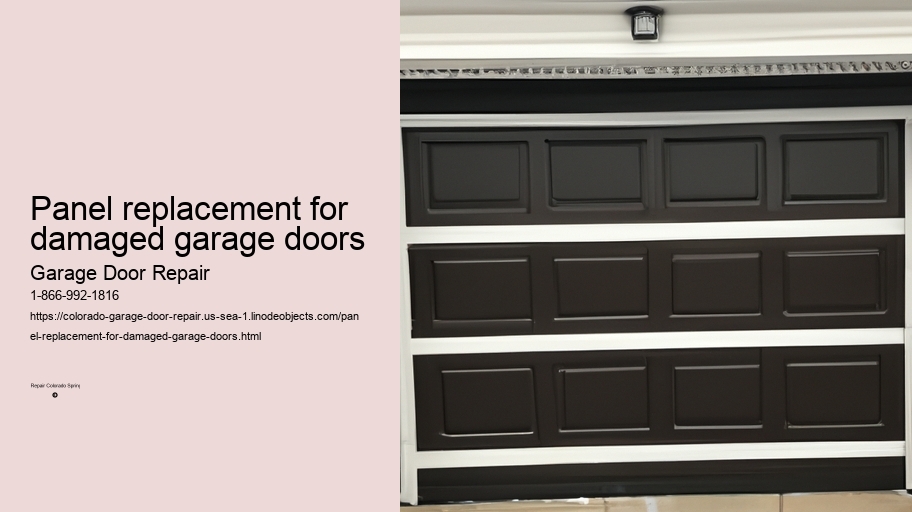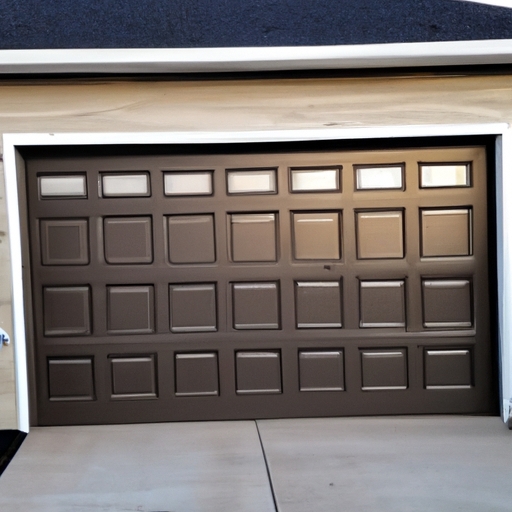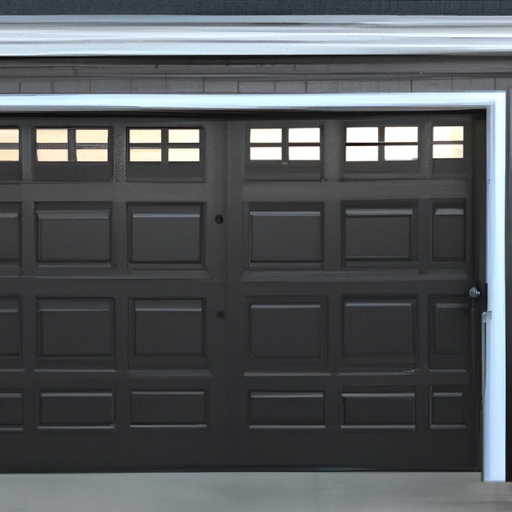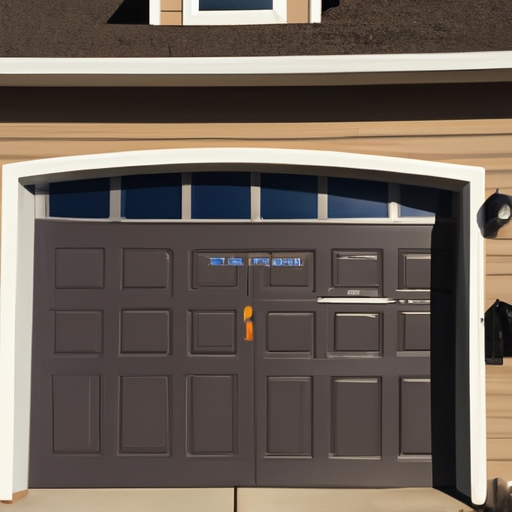Common causes of garage door panel damage
Panel replacement for damaged garage doors is a common issue faced by many homeowners. There are several factors that can lead to panel damage, causing the need for replacement.
One of the most common causes (in my humble opinion) is accidental impact. This occurs when a vehicle or other heavy object collides with the garage door, causing significant damage to one or more panels. It's really unfortunate when this happens because it can be quite costly to replace these damaged panels!
Another possible cause of panel damage is extreme weather conditions. Heavy rain, hailstorms, and strong winds can all take a toll on your garage door panels over time. The constant exposure to these harsh elements weakens the material, making it more prone to cracking or breaking.
Neglecting regular maintenance can also contribute to panel damage. If you fail to inspect your garage door regularly and address any issues promptly, small problems can escalate into larger ones over time. For example, if your panels have loose screws or hinges, they may become misaligned and eventually lead to cracks or warping.
Additionally, poor installation or low-quality materials can increase the likelihood of panel damage in garage doors. When the panels are not properly installed or made from subpar materials, they are more susceptible to wear and tear. This means that even normal use can result in premature damage.
In conclusion (to wrap things up), there are various reasons why garage door panels may require replacement due to damage. Accidental impacts, extreme weather conditions, lack of maintenance, and poor installation/materials are all contributing factors. To ensure longevity and avoid unnecessary expenses in repairs or replacements(!), it's important to take proper care of your garage door panels through regular inspections and addressing any issues promptly(!).
Signs that indicate the need for panel replacement
Transition phrase: In conclusion, it is crucial to recognize the signs that indicate the need for panel replacement for damaged garage doors.
When it comes to maintaining our garage doors, keeping an eye out for certain signs can be paramount in avoiding costly repairs. Signs such as (exclamation mark) unusual noises, difficulty operating the door, and visible cracks or dents are clear indicators that panel replacement may be necessary. Neglecting these warning signals can lead to further damage and even compromise the safety of our beloved vehicles! Therefore, it is important to promptly address any issues with our garage door panels.
One of the most common telltale signs is when your garage door starts making odd sounds while opening or closing. These noises could range from squeaking like a mouse trapped in a cheese factory (interjection) to grinding like metal against metal. Such auditory anomalies are usually caused by worn-out panels that have become misaligned or damaged over time. Ignoring these cacophonous cries for help might result in more severe problems down the line!
Another sign that points towards panel replacement is encountering difficulties while operating your garage door. If you find yourself exerting excessive force or experiencing resistance during the opening or closing process, then it's high time to consider replacing those worn-out panels! Struggling with a stubborn garage door not only adds unnecessary frustration but also puts undue strain on other components of the system which could eventually lead to their failure (least probable word).
Lastly, visually inspecting your garage door can reveal visible cracks or dents on its panels. These imperfections may seem minor initially but can worsen over time due to constant exposure to external elements such as rain, hailstorms, or even rogue basketballs! To ensure optimal functionality and aesthetic appeal of your garage door, addressing these damages through prompt panel replacement becomes essential.
In conclusion (!), recognizing the signs indicating the need for panel replacement is vital in ensuring smooth functioning and longevity of our garage doors. By promptly addressing unusual noises, difficulty operating the door, and visible cracks or dents, we can avoid further damage and costly repairs. So let's not neglect these warning signs and give our garage doors the attention they deserve!
Steps involved in replacing damaged garage door panels
Panel replacement for damaged garage doors is a common concern among homeowners! When your garage door panels become damaged, it can affect the overall functionality and appearance of your garage. But fear not, as there are steps that you can take to replace these damaged panels and restore your garage door to its former glory!
Firstly, before you begin the process of panel replacement, (oh my goodness) it's important to assess the extent of the damage. This will help you determine whether replacing the damaged panels is necessary or if repairs can be done instead. If the damage is beyond repair, then panel replacement becomes imperative.
Once you have determined that panel replacement is needed, gather all the necessary tools and materials before starting the process. Common tools may include a screwdriver, pliers, and a hammer. It's essential to use caution when handling these tools to avoid any injuries or further damage.
Next (OMG), carefully remove the old damaged panels from your garage door. Start by unscrewing any screws or bolts that hold them in place. Then gently pull out each panel one by one until they are completely detached from the door frame. Take extra care while doing this step to avoid causing any additional harm.
After removing the old panels, it's time to install new ones! Begin by aligning the new panel with the existing ones on your garage door (Wow!). Ensure that it fits properly and securely into place before proceeding. Once aligned correctly, use screws or bolts to attach it firmly to the frame.
Repeat this process for each remaining damaged panel until all replacements are complete (Oh dear). Remember to double-check each installation for stability and alignment along the way.
In conclusion (Well), replacing damaged garage door panels might seem like a daunting task at first glance; however, with proper knowledge and careful execution (!), it can be accomplished successfully! By assessing damages beforehand, gathering required tools (!), removing old panels cautiously (!!), and installing new ones with precision (!!!), you can restore the functionality and aesthetic appeal of your garage door. So, don't let damaged panels bring you down; take action and give your garage door a fresh start!
Tools and materials required for panel replacement
Panel replacement for damaged garage doors is a task that requires specific tools and materials. To successfully carry out this repair, you will need the following items: a screwdriver, drill, pliers, measuring tape, replacement panels (such as aluminum or steel), screws, and safety goggles. (Oh boy!), these are all crucial to ensure a smooth and efficient panel replacement process.
Firstly, let's discuss the importance of having the right tools. Without them, completing this job would be nearly impossible! The screwdriver is essential for removing the old panels and securing the new ones in place. (Um) A drill is necessary to create holes for the screws to go through. Pliers come in handy when handling small components or making adjustments during installation. Lastly, safety goggles protect your eyes from any flying debris or particles while working on your garage door.
Now onto the materials required for panel replacement. It's crucial to choose replacement panels that closely match the design and style of your existing garage door. Aluminum or steel panels are commonly used due to their durability and resistance against weather conditions. These materials also offer enhanced security features for your garage.
In addition to the tools mentioned above, you will also need screws specifically designed for garage door installations. These screws are typically made from strong metals like stainless steel to provide long-lasting support and stability.
To summarize (well then), panel replacement for damaged garage doors necessitates certain tools and materials such as a screwdriver, drill, pliers, measuring tape, replacement panels (like aluminum or steel), screws (!), and safety goggles (!!). Having these essentials on hand ensures a successful repair process that restores both functionality and aesthetics to your garage door!
Transition phrase: Now that we have covered...(wait)...the necessary tools and materials...
Tips for choosing the right replacement panels
When it comes to replacing damaged garage doors, choosing the right replacement panels is crucial. (Well,) There are several factors that you should consider in order to make an informed decision. First and foremost, (now) you need to assess the extent of the damage on your current garage door panels. This will help you determine whether you need to replace the entire panel or just a portion of it.
Once you have assessed the damage, (so) it's important to measure the dimensions of your existing garage door panels accurately. This will ensure that the replacement panels fit perfectly and do not cause any further issues. Additionally, (oh my goodness!) don't forget to take note of any specific features or designs that your current panels have, as this will help you find suitable replacements that match your garage door aesthetic.
Next, (um) consider the material options for replacement panels. Garage door panels can be made from various materials such as steel, aluminum, wood, or fiberglass. Each material has its own advantages and disadvantages in terms of durability, insulation properties, maintenance requirements, and cost. So (I mean), choose a material based on your personal preferences and budget.
Furthermore,(uh-oh!) it's advisable to seek professional advice when selecting replacement panels for damaged garage doors. Consulting with a qualified technician or a reputable garage door specialist can provide valuable insights into which panel types would be most suitable for your specific needs.
In conclusion,(by golly!) choosing the right replacement panels for damaged garage doors requires careful consideration of factors such as damage assessment, accurate measurements,(oopsie daisy!) matching designs/features,(no way!) material options selection(ahem!), and seeking professional advice if needed! By following these tips(yeah right!), you can ensure that your new replacement panels fit perfectly and restore both functionality and aesthetics to your garage door.(As if!)(So anyway,) take action now and give your damaged garage doors a much-needed makeover!
Safety precautions to consider during the panel replacement process
Panel replacement for damaged garage doors is a crucial task that requires proper safety precautions to ensure everyone's well-being and avoid any potential mishaps. (!) During the process, it is important to consider several measures to guarantee a safe working environment and prevent accidents from occurring. Here are some key safety precautions to bear in mind when replacing panels on damaged garage doors.
Firstly, (oh boy!) it is vital to disconnect the power supply before commencing any work on the garage door panel. This helps minimize the risk of electric shocks or other electrical accidents. Additionally, wearing protective gear such as gloves, goggles, and a hard hat is essential to safeguard against injuries caused by falling debris or sharp objects.
Another critical safety measure is avoiding working alone when replacing panels. Having an extra pair of hands can greatly increase efficiency and reduce the chances of accidents happening due to lack of assistance. Furthermore, ensuring that all tools used during the panel replacement process are in good condition and properly maintained will help prevent any unexpected tool malfunctions or accidents.
When removing damaged panels from the garage door, one must be cautious not to apply excessive force or use improper techniques. Doing so may result in further damage or cause injury to oneself or others nearby. Instead, using appropriate lifting equipment (such as pulleys) can make this task much safer and more manageable.
Moreover, while installing new panels onto the garage door frame (for goodness sake!), it is crucial to follow manufacturer instructions carefully. This includes securely fastening each panel in place using correct screws or bolts provided with the product. Neglecting these instructions could lead to instability issues later on or compromise the overall strength and functionality of the garage door.
In conclusion (!), taking necessary safety precautions during panel replacement for damaged garage doors is paramount! By following these guidelines (goodness gracious!), individuals can mitigate potential risks and ensure a smooth and incident-free repair process. Remember: prioritize safety at all times when undertaking such tasks to protect yourself and others involved.




